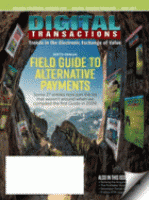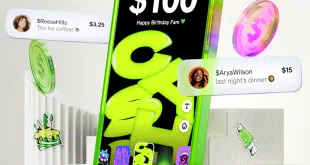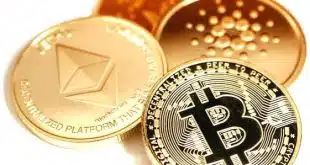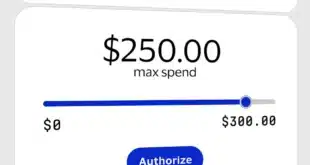Restaurants have been slow to bite on EMV. To get adoption percolating, vendors are introducing methods that let customers add a tip after making a payment or pay with tabletop devices.
Paying with EMV cards has been an adjustment for the average U.S. consumer. Cards are no longer swiped. They are inserted into the point-of-sale terminal. And, two years after EMV began rolling out in earnest, many consumers still forget to remove their card from the terminal when their transaction is complete.
But those are relatively minor changes of habit. Where EMV has really upended the consumer-payment experience is in restaurants. Consider the traditional model: You hand a server your card; he or she then swipes it through a POS terminal away from the table to authorize the cost of the meal; the server then returns the card with a receipt, to which the diner can add a tip while lingering over coffee. That model has worked well for decades, but it doesn’t fit the needs of restaurant EMV.

While the process creates a single transaction that is easier for the restaurant and its processor to manage during settlement, it is a foreign concept to restaurant goers in the United States, and can disrupt the flow of the meal. Plus, entering a tip in the presence of the waiter or waitress can make a diner feel uncomfortable.
Given these issues, it not surprising that EMV adoption among restaurants where patrons are served at the table is lagging. Within this segment, the percentage of restaurants adopting EMV is in the single digits, says Jared Isaacman, chief executive for Harbortouch, an Allentown, Pa.-based provider of POS systems to merchants, including restaurants.
Adoption among quick-service restaurants, where customers order and pay for their meal at the counter, is better, but still lagging behind adoption rates for retailers in general, Isaacman says.
The lag in EMV adoption in both categories is attributable to different factors. Many QSRs are not enabling EMV out of concern that consumers will perceive inserting a chip card into a terminal and entering their PIN as additional steps that slow down the transaction, payments experts say. Currently, many QSRs do not require a signature on card transactions below a certain threshold precisely to speed checkout and increase customer satisfaction.
For restaurants where customers are served at the table, the barrier to EMV adoption is that idea of paying and tipping all in one transaction at the table.
“In the U.S., owners of sit-down restaurants are reluctant to disrupt the flow of the dining experience by bringing a POS terminal to the table to pay for the meal and enter a tip,” says Drago Dzerve, vice president of product management for San Jose-based POS terminal maker VeriFone Systems Inc.
‘Urban Legend’
To surmount that barrier, several processors and POS solution providers have developed an application called “tip adjust,” which allows chip card holders to pay for a meal and tip just as they would with a mag-stripe card.
The tip-adjust application is integrated into a restaurant’s POS system, which tracks such data as the number of tables seated and which tables have been assigned to individual waiters, and performs such business functions as inventory management and time and attendance for the staff. It also submits card payments to the restaurant’s processor.
With tip adjust, servers do not need to bring a POS terminal to the table. Instead, the transaction can be carried out much as it is with a mag-stripe card. Away from the table, a server runs the customer’s card through an EMV-enabled payment terminal integrated with the restaurant’s POS system to authorize payment.
Once authorization is complete, the server returns the card to the customer with a paper receipt that includes the option of adding a tip. The customer then adds the tip at his leisure and signs the receipt. The tip can then be added as a post-authorization adjustment.
The process is acceptable under Visa Inc. and Mastercard Inc. rules for EMV transactions. Both card companies say they support post-transaction tip adjustments on EMV cards for up to an additional 20% of the bill. “It’s an urban legend that EMV can’t work like the mag-stripe model in restaurants,” says Steve Mathison, senior vice president for network relations at the big processor First Data Corp.
‘A Certain Amount of Unknowns’
Visa’s and Mastercard’s support for post-transaction tip adjustments was born out of the realization that, when the EMV liability shift went into effect in late 2015, there were not a lot of alternative EMV solutions available to restaurants to pay at the table.
“The product-development cycle for restaurant POS systems can take one to two years, and the card brands misunderstood the technological readiness of restaurants to support EMV when it began rolling out,” says Paul Hunter, president of Tampa, Fla.-based Sterling Payment Technologies. “The restaurant industry needed more time to develop new solutions, which are now coming to market.” Sterling offers tip adjust as a standard feature of its POS solution.
So far, adoption of tip adjust has been slow but steady, according to processors and POS solutions providers offering it. “We have a number of merchants using tip adjust and we’d like to see that number continue to grow as we educate more merchants about EMV,” says Terri Harwood, chief operating officer for Troy, Mich.-based North American Bancard Holdings LLC. “There appears to be a certain amount of unknowns with EMV in general, but that is most likely attributable to a general lack of education about EMV and the solutions that are available.”
North American Bancard processes more than $36 billion in transactions annually for more than 250,000 merchants, including restaurants.
‘Frustrating’ Delays
Low levels of fraud are another factor contributing to the anemic adoption of EMV among sit-down restaurants and QSRs, Mastercard says. While fraud has moved to markets not supporting EMV as chip cards have rolled out, such as e-commerce, that has not been the case for restaurants, payment experts say. The low fraud rates incurred by restaurants created a mindset among restaurateurs that they simply don’t incur chargebacks, Harwood says.
That perception is beginning to change now that card companies are making it clear to restaurants they can be liable for fraud. “Restaurants now have an exposure that they never had, so we have a great opportunity to educate restaurants about steps they can take to provide that security,” Harwood says.
For some restaurants, the liability shift alone is not enough to prompt them to purchase EMV terminals, especially if they may incur only a few chargebacks per year. Besides, payments experts point out that criminals don’t look to perpetrate fraud in restaurants because they cannot resell a meal they have consumed, and they tend to avoid making fraudulent transactions in person.
“There is not enough return on investment from the EMV liability shift alone for restaurants to justify installing EMV,” says Viren Balar, co-founder and chief technology officer for Ziosk, a Dallas-based maker of tabletop ordering tablets for restaurants. “Providing an EMV-enabled terminal that improves the customer experience is a better business case for restaurants.”
In addition to allowing customers to electronically place an order, Ziosk’s terminal lets consumers pay for their meal and include a tip using a chip card. The company has deployed 170,000 of its tablets in more than 3,000 restaurant locations, including those of Chili’s, Olive Garden, Red Robin, TGI Friday’s, Outback Steakhouse, and UNO Pizzeria & Grill.
The Ziosk terminal also accepts payments from NFC-enabled mobile wallets, gift cards, and QR codes generated by mobile-payment apps on smart phones.
The convenience of paying at the table and including a tip without a server having to bring a wireless, handheld POS terminal to the customer increases the average tip amount by about 10%, Balar says.
“One of the advantages of having a terminal at the table is that the customer does not have to wait for the server to bring a terminal to them when they are ready to pay and go,” says Balar. “When a customer is ready to leave, delays in paying the bill can be frustrating.”
‘Significant Risks’
As companies such as Ziosk develop alternatives for EMV pay-at-the table solutions, payments experts agree that non-chain, sit-down restaurants are more likely to adopt a tip-adjust solution or pay at the table solution now that such applications can be integrated with their legacy POS systems. Which option a restaurateur chooses depends on their established workflows and the customer experience.
A sit-down restaurant that requires its customers to pay at the counter on their way out, for example, can add a traditional EMV terminal that requests the tip be entered along with the amount of the meal, while a restaurant that prefers that customers pay at the table can adopt a tip-adjust solution.
“There is more than one way for restaurants to adopt EMV solutions,” says Derek Webster, founder and chief executive of CardFlight Inc., a New York based-provider of mobile POS solutions. “What method is chosen depends on the restaurant’s operational workflows.”
The need to replace aging payment technology, along with a broader adoption of EMV terminals in general by merchants, is also likely to prompt restaurants to take a harder look at adopting EMV solutions to avoid being the last of the holdouts, payments experts say.
“There are significant risks and penalties for being among the last to adopt EMV,” says Mathison.
Sit-down restaurants are starting to evaluate adopting the pay-at-table options and QSRs are considering updating their payment infrastructure to allow for PIN entry at drive-thru windows, Mastercard says.
‘It’s Going To Take Years’
Even so, while American consumers’ preference for adding a tip after paying for their meal is expected to give tip-adjust applications more legs in the near-term with sit-down restaurants, don’t expect the migration to be swift.
“Replacement of POS technology happens annually in the restaurant industry, so restaurants will invest in EMV as they need to replace aging equipment,” says Isaacman. “But with tip-adjust solutions just coming into the market, it’s going to take years to complete those technology swaps. You can’t just wave a magic wand and expect tip adjust or pay at the table to be put in place.”




